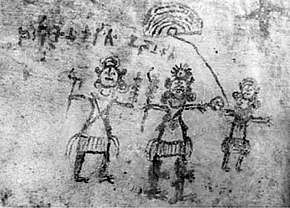Tikla
Tikla, or Tikula, is an archeological site and ancient rock shelter in Madhya Pradesh, India, known for its petroglyphs.[1][2][3] Tikla is around 170 kilometers south of Mathura, and 50 kilometers southwest of Gwalior, on the road from Mathura to Tumain and Ujjain.[1] It is located on the right bank of the Parvati river, about one kilometer from Mohana (मोहना) town on the Agra-Bombay road.[4]

Probably the earliest known Indian depiction of the Mathuran known as the Vrishni heroes, is a rock painting found at Tikla.[1] This rock painting is dated to the 3rd-2nd century BCE, based on the paleography of the Brahmi inscription accompanying it.[1] The deities are depicted wearing a dhoti with a peculiar headdress, and are shown holding their attributes: a plow and a sort of mace for Balarama, and a mace and a wheel for Vāsudeva. A third smaller character is added, forming what can be called a Vrishni trio, in the person of a female, thought to be the Goddess Ekanamsha, who seems to hold a Chatra royal umbrella.[1] These depictions belong to "Period IV" of the rock shelter, and are accompanied by contemporaneous images of elephant riders, horse riders and flowers.[5]
Tikla has a famous carved petroglyph representing a maze. It is the earliest known maze design in India, is dated to 250 BCE, and it is thought that the design was introduced with the campaigns of Alexander the Great.[6]
References
- Gupta, Vinay K. Vrishnis in Ancient Literature and Art. pp. 70–72.
- Chakravarty, Kalyan Kumar; Bednarik, Robert G.; Saṅgrahālaya, Indirā Gāndhī Rāshṭrīya Mānava (1997). Indian Rock Art and Its Global Context. Motilal Banarsidass Publ. p. 85. ISBN 978-81-208-1464-6.
- Tiwari, Shiv Kumar (2000). Riddles of Indian Rockshelter Paintings. Sarup & Sons. p. 19. ISBN 978-81-7625-086-3.
- "Subsequently, the rock shelters were discovered at Tikla village situated on the right bank of Parvati river at a distance of one km from Mohna town on the Agra- Bombay road." Sharma, Raj Kumar; Tripathi, K. K.; Pandey, Shyam Kumar (1996). Recent Perspectives on Prehistoric Art in India and Allied Subjects: Essays in Honour of Dr. Shyam Kumar Pandey. Aryan Books International. p. 149. ISBN 978-81-7305-070-1.
- "Period IV In this period, the figures of Balarama, Krishna, elephant rider, horse rider and flower decoration are depicted." in Sharma, Raj Kumar; Tripathi, K. K.; Pandey, Shyam Kumar (1996). Recent Perspectives on Prehistoric Art in India and Allied Subjects: Essays in Honour of Dr. Shyam Kumar Pandey. Aryan Books International. p. 149. ISBN 978-81-7305-070-1.
- "The earliest datable example is a cave painting at Tikla in Madhya Pradesh, India, from around 250 BCE...." Bounford, Julie E. (2018). The Curious History of Mazes: 4,000 Years of Fascinating Twists and Turns with Over 100 Intriguing Puzzles to Solve. Wellfleet Press. p. 11. ISBN 978-0-7603-6302-7.
